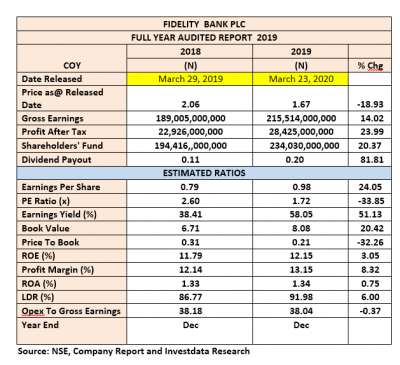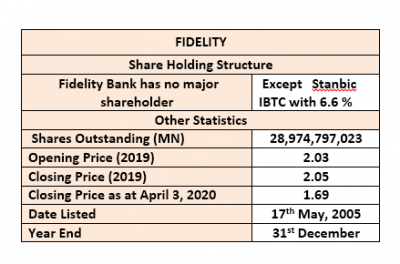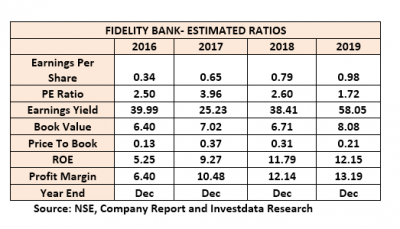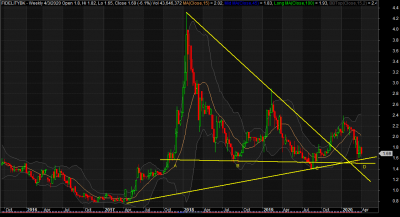The management of Fidelity Bank Plc recently submitted its audited financials for the full-year ended December 31, 2019, to the Nigerian Stock Exchange (NSE) earlier than the released date of the 2018 numbers. This early presentation of the result in line with the post-listing requirement of the exchange will help investors plan, given that consistency aids prediction and timing of investments.
Top and bottom-lines improved when compared with those of 2018. Specifically, Gross Earnings climbed 14.02% up from N189.01bn in 2018 to N215.51bn, while Profit rose at a faster 23.99% rate from N22.93bn in 2018 to N28.43bn.
The numbers which ranked Fidelity Bank as the most improved in the period under review were boosted by net interest income and credit writeback, following which Earnings Yield stood at 58.05%, compared to the previous year’s 38.41%.
This was driven by the 30% growth in loan and advances, even as Net Asset for the period improved by 20.37% to N234.03bn implies that Fidelity Bank is able to meet the planned recapitalisation in the banking industry as envisaged by the Central Bank of Nigeria (CBN) in its medium to long-term plan.
The drop in the bank’s Non-Performing Loan ratio to 3.3% from 5.7% in 2018 is a reflection of the improvement in Fidelity Bank’s asset quality and risk management, despite the strong growth in total loan book during the period. This was despite the challenging business environment sign-posted by the low-interest rates in Treasury Bills, the oscillating oil price for the period and other factors.
Earnings per share estimates from the said period resulted in 0.98 kobo, compared to the prior year’s 0.79 kobo, while the fall in its share price during the period has shortened the investment period to 1.72x, which has reduced investors waiting period from 2.60x. The said Earnings yielded 58.05% on the released day. This is above the 38.41% yield estimated in 2018, just as Return on Equity increased from 11.79% in 2018 to 12.15% in 2019. There was also a marginal improvement in Profit Margin of 13.19%, from 12.14% in the previous year.

Fidelity Bank Plc began operations in 1988 as Fidelity Union Merchant Bank Limited. By 1990, it had distinguished itself as the fastest growing merchant bank in the country. However, in 1999, it converted to commercial banking and changed its name to Fidelity Bank Plc and became a universal bank in February 2001, with a license to offer the entire spectrum of commercial, consumer, corporate and investment banking services. Fidelity Bank.

Four-Year Performance Analysis
The bank’s gross earnings over this period have grown consistently with an average growth of over 41.77% between 2016 and 2019, from N152.01bn in 2016 to N215.51bn in 2019. The years 2016 and 2017 were the period Nigeria slipped into economic recession and recovery, which impacted the bank’s figures negatively. The high NPL ratio, however, slowed down the dividend payout of 2017 and 2018, before the 20 kobo dividend reported in 2019, representing an 81.81% growth and yield of 11.96% as at released date.
Nevertheless, the noticeable improvement in operations in the 2018 and 2019 financial years was attributed to internal restructuring by the bank as it sought to drive deposit and provide satisfactory service to its customers.
Its profit level since 2016 continues to look up, remaining on the path of strong growth, which has supported the bank’s share price, despite fluctuations due to market dynamics and fundamentals.
Fidelity Bank’s earnings power has maintained an upward movement in the last four years as a result of strong leadership and commitment to deliver value at all levels and time.
Profit for the period rose from N9.73bn in 2016 to N18.86bn in 2017 which was more a 100% increase, a trend that was sustained in the 2018 and 2019 financial years, when climbed first to N22.93bn, from N28.43bn respectively.
Shareholders’ funds for the period maintained an uptrend growth of 26.23%, soaring from N185.4bn in 2016 to N234.03bn in 2019.

Estimated Performance Ratios
The bank’s Earnings Per Share for the period is a reflection of its earnings power, which grew from 34 kobo in 2016 to 98 kobo estimated from 2019 released financials. The said EPS is the same as 1.72x (times) of the market price at released date and yielded 58.05% of the market price from the Price to Earnings ratio of 2.5x in 2016. Its Book Value looks attractive at N8.08 per share, a growth that boosted confidence, while assuring investors of further growth, despite the fluctuation in price and market trend. The growth in EPS was attributed to an increase in Net Fee and Commission Income which, in our view, is the mainstay of the bank’s non-interest income. Key drivers of the improvement in net fees and commission were stronger credit fees and improved ATM and account maintenance charges. We note that the growth in non-interest income was stifled by weaker net FX gains.

Valuation
The Bank 2019 book value per share stands at N8.08 while the Price to Book Value (PBV) is 0.21. On the strength of its Price-Earnings-Ratio of 1.72x, which is relatively low in its sector. The share price of Fidelity Bank is fairly and technically placed at N4.00 per share.

As future earnings of the bank is expected to improve on the heels of its corporate banking business and increased focus on the retail market. The bank’s price action has been trending down, just as it broke down the strong support level at N1.65 trading between the high of N2.40 and low of N1.44 each. Investors are therefore advised to play within the said trading range.
In other words, the position can be taken at this appropriate price support level.
More importantly, Fidelity Bank is good for all investment goals, whether for short or long-term.
We note that this bank survived the meltdown and has consistently paid dividends on positive earnings that have supported its price.








